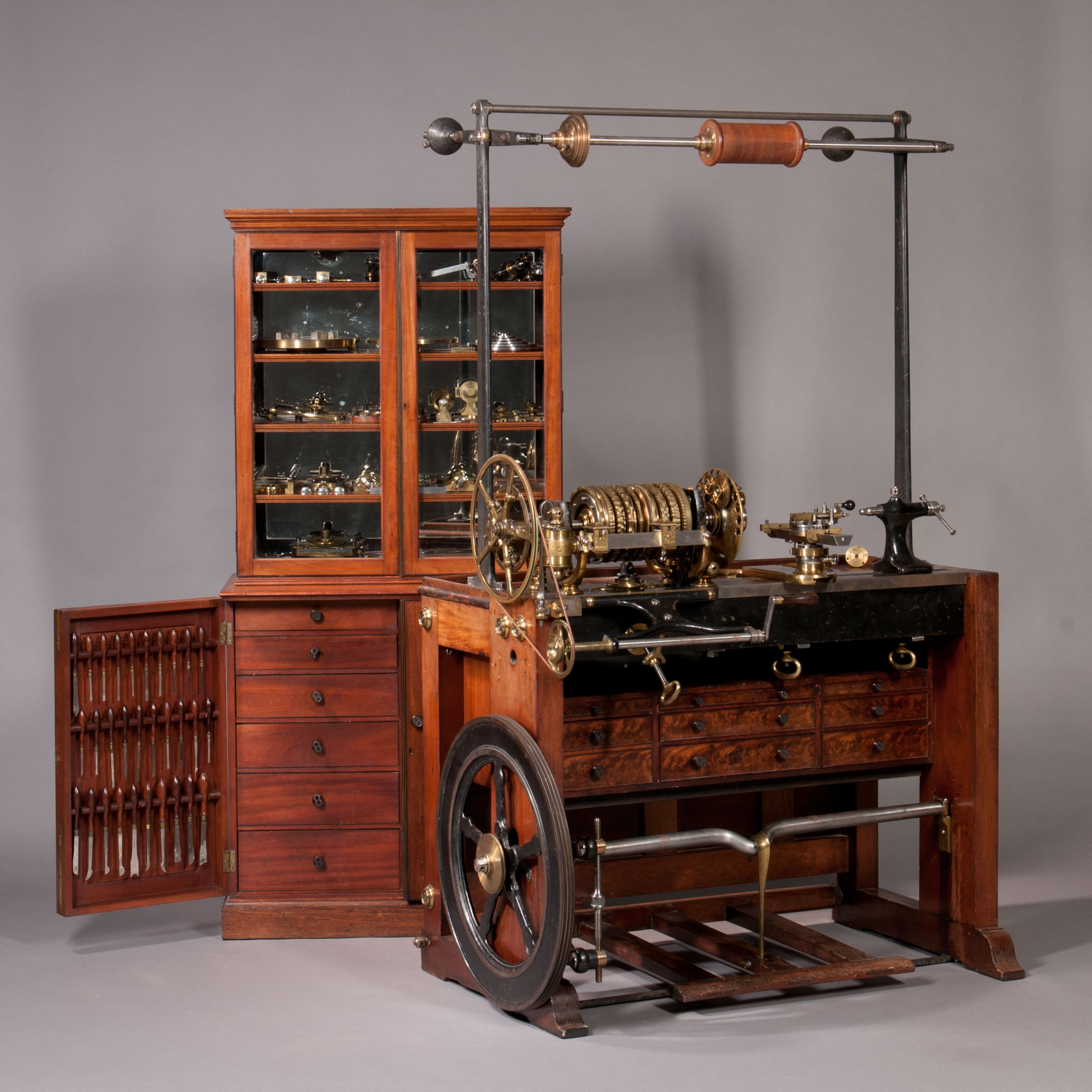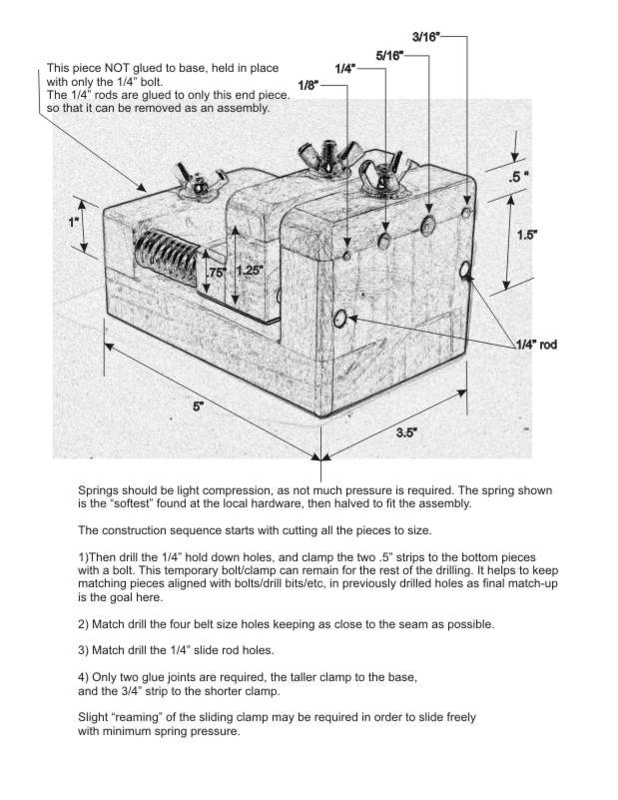Overview
The Holtzapffels made 2,557 lathes between 1795 and 1928, but only 15 (or maybe fewer) of them were rose engine lathes. When any of those 15 are in great shape, they are some of the most amazingly beautiful machines you can imagine.
They may be used, but you won't find them on eBay or Craig's List, and they aren't cheap: The last complete one sold was in 2012 for $228,000 (shown in the picture on the right).
That Holtzapffel machine, #1636, is considered by many to be the finest rose engine lathe ever built, and it was delivered to the 1st owner in 1886.
This rose engine and a number of others are currently owned by, and can be used at, the Plumier Foundation (which also owns and uses other historical woodworking equipment).
The Plumier Foundation has been created to teach, encourage and preserve the practices of ornamental turning and fine woodworking. Ornamental turning is an extraordinary collaboration between art and science that has created technical and aesthetic marvels over the past several centuries. Fine woodworking also has a rich history of bringing a craftsperson's hands and eyes together to join and shape mankind's greatest renewable natural resource, wood, into objects of useful art. The Plumier Foundation's goal is to keep these skills alive by offering practical, hands-on instruction in the use of vintage machines and hand tools in a manner that respects the past while moving ornamental turning and fine woodworking forward in a fresh and creative manner. To this end, Plumier Foundation serves as a unique resource providing access to knowledge and tools for practitioners of ornamental turning and fine woodworking to use.
The Plumier Foundation's goal is to be a palace, refuge, and studio for masters in ornamental turning and fine woodworking. Its intention is to create a community of those who have reached mastery, those who aspire to higher levels of accomplishment, and those who simply want to encourage the preservation of these skills. This community is developed with the idea that the mastery of a craft is a vocation, a calling, to which a person must respond. Through the development of this community, the Plumier Foundation not only passes on skills and knowledge multi-generationally but also functions as a prescriptive means of alleviating the individual craftsperson's sense of loneliness and futility often associated with the arts and crafts.
To achieve the above objectives, the Plumier Foundation provides an extraordinarily well-equipped shop in which students can learn and around which curious minds can gather. It offers a place where masters can demonstrate and pass on their skills and those on their way to mastery can learn in a hands-on manner. Through classes, self-study, guided long and short-term stays, and open house programs, the Plumier foundation brings together a wide community of participants. In this way, it preserves and enhances our historical heritage of ornamental turning and fine craftsmanship in wood and supports a creative and productive future for these activities.->
If you do buy one, please do consider that one is not considered the owner of a Holtzapffel lathe: merely the current care-taker.
The Plumier Foundation's web site has some great videos of this machine in use. I encourage you to look there and at the Plumier Foundation's YouTube channel.
########################################################################
### Additional pictures of this device
########################################################################
Additional pictures of this device
########################################################################
### Examples of work produced with this device
########################################################################
Examples of work produced with this device
########################################################################
### Examples of this device in use
########################################################################
Examples of this device in use
########################################################################
### Usage notes
########################################################################
########################################################################
### How it works
########################################################################
########################################################################
### Notes on making one
########################################################################
########################################################################
### Notes on making parts for one
########################################################################
Notes on making parts for one
Holtzapffel Threads
The threads used on Holtzapffel machinery are outlined in this table.
|
External
Diameter
(inches)
|
Letter
Nos.
|
Thread
TPI
|
Pitch
|
Change-wheels
with Guide Screw
of 1/4" pitch
|
|
1.000
|
A 1
|
6.58
|
5
329
|
50x40
70x47
|
|
0.875
|
B 2
|
8.25
|
4
33
|
48x80
60x110
|
|
0.750
|
C 3
|
9.45
|
20
189
|
50x80
90x105
|
|
0.625
|
DD 4
|
13.09
|
100
1309
|
20x100x50
70x55x85
|
|
0.560
|
D 4
|
|
0.500
|
E 4
|
|
0.450
|
F 5
|
16.5
|
2
33
|
40x80
110x120
|
|
0.410
|
G 6
|
19.89
|
100
1989
|
20x50x100
65x85x90
|
|
0.360
|
H 6
|
|
|
7
|
22.1
|
10
221
|
25x40
65x85
|
|
0.330
|
I 8
|
22.65
|
20
513
|
20x100
95x135
|
|
0.290
|
J 8
|
|
0.250
|
K 8
|
|
0.210
|
L 9
|
28.9
|
25
722
|
20x50
85x85
|
|
0.240
|
M 10
|
36.1
|
10
361
|
25x40
95x95
|
|
0.200
|
N 10
|
|
0.180
|
O 10
|
|
0.190
|
P 11
|
39.9
|
10
399
|
25x40
95x105
|
|
0.162
|
Q 11
|
|
0.150
|
R 12
|
55.0
|
1
55
|
20x40
100x110
|
|
0.135
|
S 12
|
|
0.120
|
T 12
|
|
0.100
|
U 12
|
From Newnes Engineer's Reference Book, pg. 632
More Information
Published Articles
- Evans No. 1292 and Holtzapffel Eccentric Rosework Apparatus by Nicholas Edwards. The Society of Ornamental Turners Bulletin 141, Autumn, 2019, pg. 23
- Holtzapffel's Register of Lathes-correction of scanned version by Richard Boughton. The Society of Ornamental Turners Bulletin 147, Autumn, 2022, pg. 20
- Holtzapffel's Threads by Mike Windsor. The Society of Ornamental Turners Bulletin 136, Summer, 2017, pg. 31
- Matching the Finish of a Holtzapffel Lathe Mahogany Stand by Rob Lichty. Ornamental Turners International Newsletter, Volume 21, No. 2 - Summer, 2014, pg. 8
Books and Papers
Web Sites
Presentations
- Jon Sauer and his Holtzapffel lathe #2237 made in 1868, showing how he received it, restored it, and uses it by Jon Sauer. 1995 OTI Symposium (Penn Valley, CA)
Other
########## Standard Footer for all pages ##########
|
About this Site
Disclaimer: eMail comments to me at OTBookOfKnowledge @ Gmail.com. The process of woodturning involves the use of tools, machinery and materials which could cause injury or be a health hazard unless proper precautions are taken, including the wearing of appropriate protective equipment.
|


